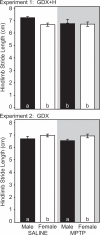Sex differences in motor behavior in the MPTP mouse model of Parkinson's disease
- PMID: 20347863
- PMCID: PMC2866026
- DOI: 10.1016/j.pbb.2010.03.009
Sex differences in motor behavior in the MPTP mouse model of Parkinson's disease
Abstract
Sex differences in Parkinson's disease (PD) have been reported in humans and rodent models, with a higher incidence in men and increased severity in male rodents. The current study examined sex differences and the effects of gonadal steroid hormones in the 1-methyl-4-phenyl-1,2,3,6-tetrahydropyridine (MPTP)-lesioned mouse model of PD. Male (n=51) and female (n=50) mice were gonadectomized and received physiologic replacement with testosterone or estrogen (Experiment 1), or no hormones (Experiment 2). Two weeks later, mice received either MPTP (10 mg/kg per day for 5 days) or saline. Higher doses killed female mice. Mice were tested one week after MPTP for motor performance using rotarod, pole and gait tests. In hormone-treated mice, males significantly outperformed females in all three tests (p<0.05). Compared with females, males had a greater overall rotarod performance (ORP: 1317.1+/-98.3 vs. 988.1+/-95.6), descended a pole faster (7.1+/-0.6 vs. 9.6+/-0.7s), and had longer stride lengths (hindlimb 7.3+/-0.1 vs. 6.8+/-0.1cm). By contrast, ovariectomized female mice receiving saline outperformed castrated males on the rotarod (1296.6+/-83.3 vs. 811.2+/-113.7, p<0.05) and descended a pole faster (9.7+/-2.0 vs. 15.6+/-1.9s, p<0.05). MPTP significantly impaired ORP (p<0.05) in hormone-treated males (703.7+/-65.5) and females (432.8+/-88.6, p<0.05). After MPTP, stride length was selectively decreased in males (hindlimb 6.6+/-0.1 cm, p<0.05), and pole test performance was unimpaired in either sex. After gonadectomy, MPTP did not decrease motor performance in males (p>0.05) but significantly reduced ORP in females (975.9+/-110.3 vs. saline females, p<0.05). Our results show that small, chronic doses of MPTP produce subtle, sexually-dimorphic impairments in motor performance, but without a loss of tyrosine hydroxylase-positive neurons in the substantia nigra. In gonadectomized mice, this sex difference is reversed.
Copyright 2010 Elsevier Inc. All rights reserved.
Figures




Similar articles
-
Intervention with exercise restores motor deficits but not nigrostriatal loss in a progressive MPTP mouse model of Parkinson's disease.Neuroscience. 2015 Jul 23;299:156-74. doi: 10.1016/j.neuroscience.2015.04.069. Epub 2015 May 2. Neuroscience. 2015. PMID: 25943481
-
Combining nitric oxide release with anti-inflammatory activity preserves nigrostriatal dopaminergic innervation and prevents motor impairment in a 1-methyl-4-phenyl-1,2,3,6-tetrahydropyridine model of Parkinson's disease.J Neuroinflammation. 2010 Nov 23;7:83. doi: 10.1186/1742-2094-7-83. J Neuroinflammation. 2010. PMID: 21092260 Free PMC article.
-
Quantitative assessment of gait and neurochemical correlation in a classical murine model of Parkinson's disease.BMC Neurosci. 2012 Nov 14;13:142. doi: 10.1186/1471-2202-13-142. BMC Neurosci. 2012. PMID: 23151254 Free PMC article.
-
Damage to the nigrostriatal system in the MPTP-treated SAMP8 mouse.Neurosci Lett. 2008 Dec 26;448(2):184-8. doi: 10.1016/j.neulet.2008.10.070. Epub 2008 Oct 25. Neurosci Lett. 2008. PMID: 18977411
-
Social enrichment attenuates nigrostriatal lesioning and reverses motor impairment in a progressive 1-methyl-2-phenyl-1,2,3,6-tetrahydropyridine (MPTP) mouse model of Parkinson's disease.Neurobiol Dis. 2012 Mar;45(3):1051-67. doi: 10.1016/j.nbd.2011.12.024. Epub 2011 Dec 14. Neurobiol Dis. 2012. PMID: 22198503
Cited by
-
The detection of age-, gender-, and region-specific changes in mouse brain tocopherol levels via the application of different validated HPLC methods.Neurochem Res. 2018 Nov;43(11):2081-2091. doi: 10.1007/s11064-018-2630-8. Epub 2018 Sep 7. Neurochem Res. 2018. PMID: 30194607
-
Sex differences and steroid modulation of cardiac iron in a mouse model of iron overload.Transl Res. 2014 Feb;163(2):151-9. doi: 10.1016/j.trsl.2013.08.004. Epub 2013 Sep 7. Transl Res. 2014. PMID: 24018182 Free PMC article.
-
Allopregnanolone and neurogenesis in the nigrostriatal tract.Front Cell Neurosci. 2014 Aug 12;8:224. doi: 10.3389/fncel.2014.00224. eCollection 2014. Front Cell Neurosci. 2014. PMID: 25161608 Free PMC article. Review.
-
PET Imaging with [18F]ROStrace Detects Oxidative Stress and Predicts Parkinson's Disease Progression in Mice.Antioxidants (Basel). 2024 Oct 12;13(10):1226. doi: 10.3390/antiox13101226. Antioxidants (Basel). 2024. PMID: 39456479 Free PMC article.
-
Effects of Fluoride Long-Term Exposure over the Cerebellum: Global Proteomic Profile, Oxidative Biochemistry, Cell Density, and Motor Behavior Evaluation.Int J Mol Sci. 2020 Oct 2;21(19):7297. doi: 10.3390/ijms21197297. Int J Mol Sci. 2020. PMID: 33023249 Free PMC article.
References
-
- Alvarez-Fischer D, Henze C, Strenzke C, Westrich J, Ferger B, Hoglinger GU, Oertel WH, Hartmann A. Characterization of the striatal 6-OHDA model of Parkinson's disease in wild type and alpha-synuclein-deleted mice. Exp Neurol. 2008;210:182–193. - PubMed
-
- American College of Sports Medicine . Position Statement: Senate hearing on the abuse of anabolic steroids and their precursors by adolescent atheletes. American College of Sports Medicine; 2006.
-
- Barkley MS, Goldman BD. The effects of castration and Silastic implants of testosterone on intermale aggression in the mouse. Horm Behav. 1977;9:32–48. - PubMed
-
- Benedetti MD, Maraganore DM, Bower JH, McDonnell SK, Peterson BJ, Ahlskog JE, Schaid DJ, Rocca WA. Hysterectomy, menopause, and estrogen use preceding Parkinson's disease: an exploratory case-control study. Mov Disord. 2001;16:830–837. - PubMed
Publication types
MeSH terms
Substances
Grants and funding
LinkOut - more resources
Full Text Sources

